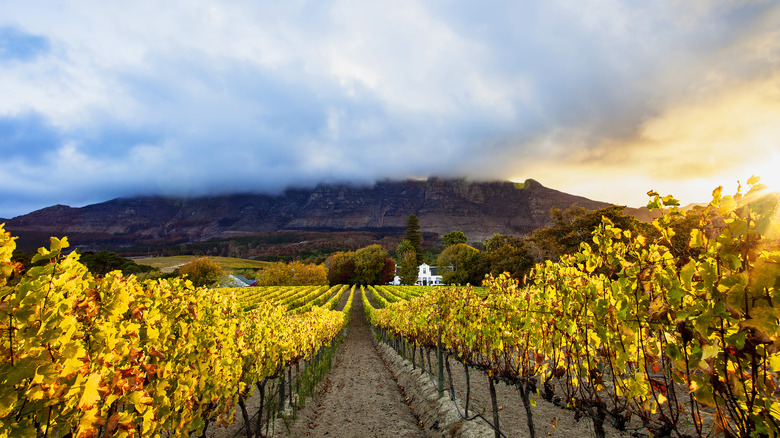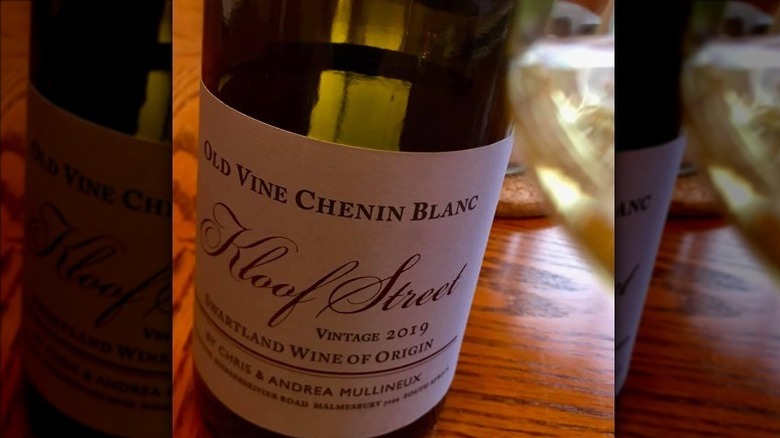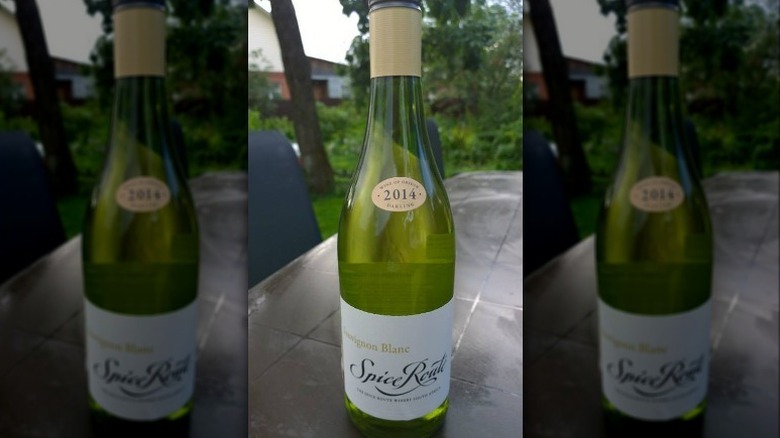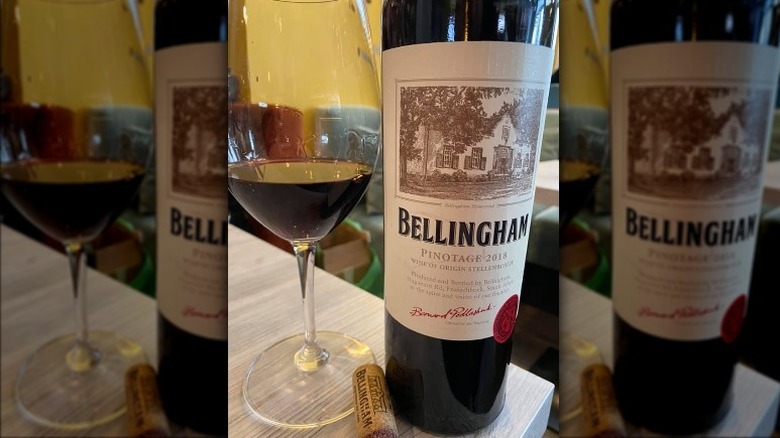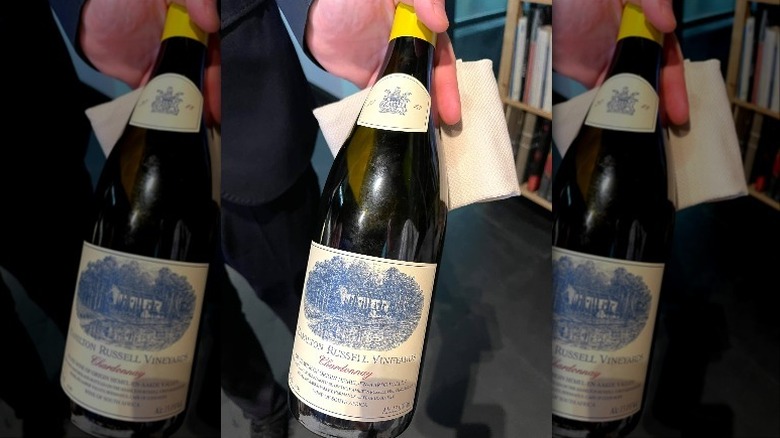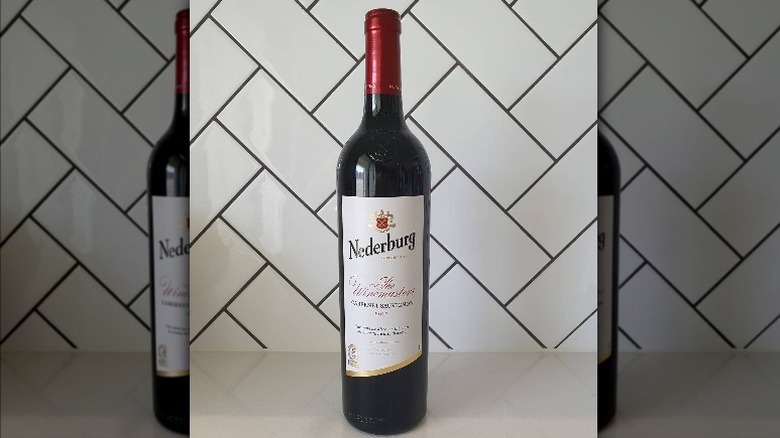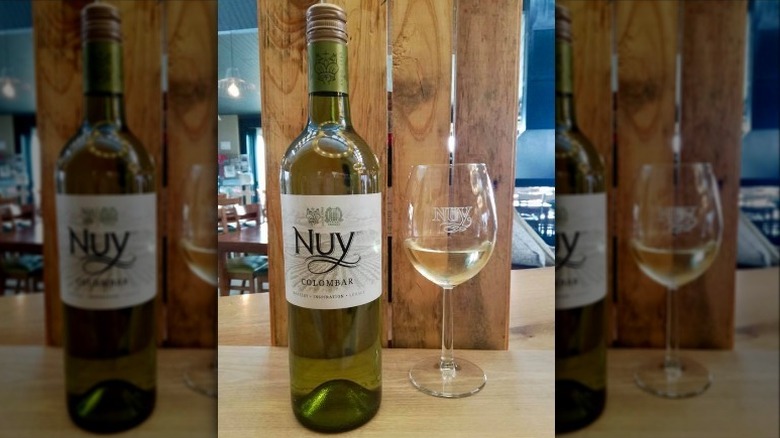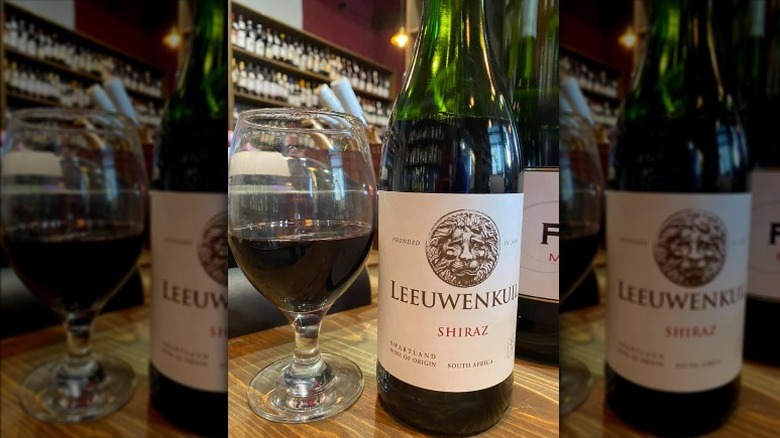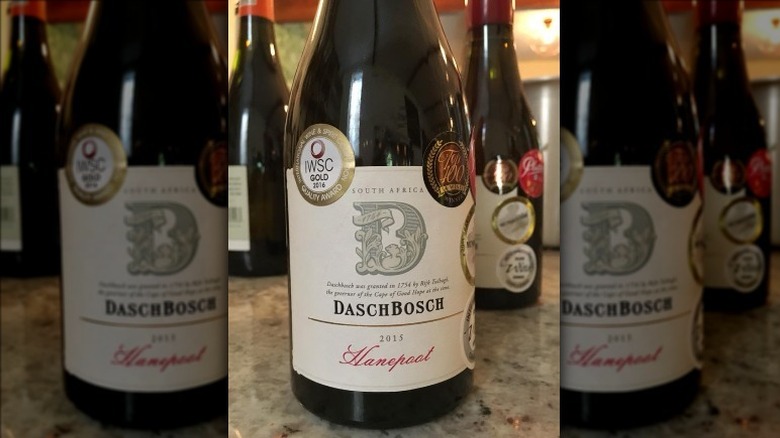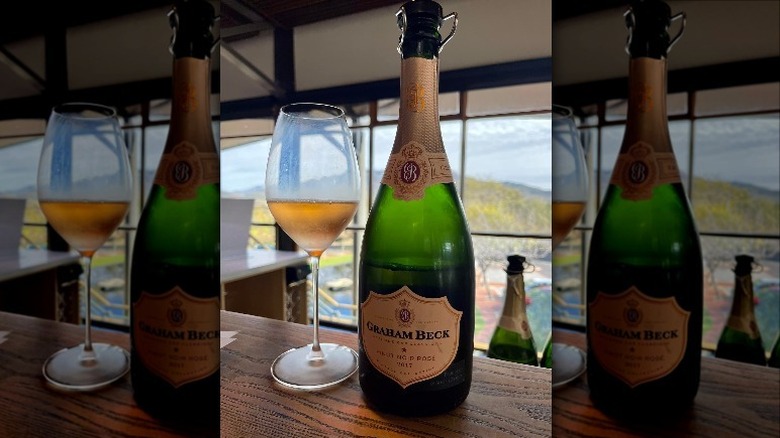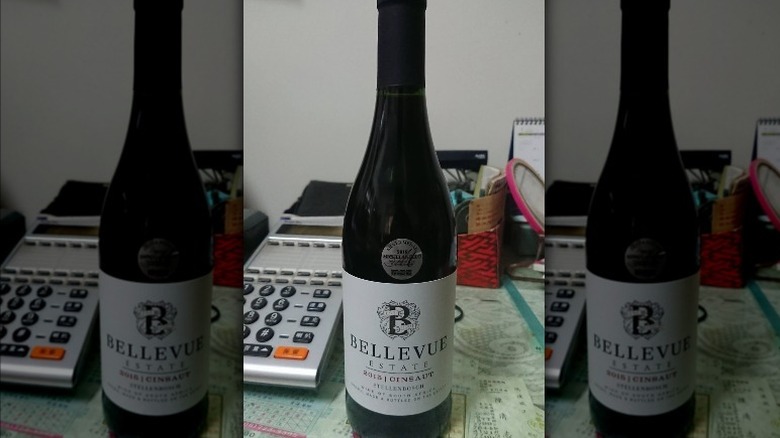Explore South Africa With These 10 Wines
South Africa has a unique wine-growing history. In some ways, South Africa has been producing wine for a long time — according to Winebow, members of the Dutch East India Company started planting vines all the way back in 1655. But it hasn't necessarily been a smooth journey for the country's winemakers. British colonizers expanded the area under vine, but wine production went down as the U.K. and France began to trade with one another more. Phylloxera, an insect that caused the widespread destruction of European vines in the late 19th century, hit South Africa as well. Then, in the 1960s, many countries in the world imposed sanctions on South Africa due to apartheid. But by 1994, when apartheid ended, South African wine production was on track to keep growing.
These days, South Africa is especially known for producing chenin blanc, pinotage, and traditional method sparkling wines. Especially considering the fact that the vineyard area only covers a small portion of the country, South African wines have made a name for themselves in the past several decades. Let's take a look at some of South Africa's most famous wines. Who knows? It may inspire to you open a bottle.
Swartland — Chenin Blanc
If there's one white grape that South Africa is known for, it has to be chenin blanc. Chenin blanc is a special grape because it's so versatile. Not only can it be used to make dry wines, but it can also produce sweet wines as well. It's beloved as a still wine, but it's often utilized in sparkling wine production too. Like chardonnay, it can be full-bodied and oily or take on more of an acidic, refreshing character. And if you want to try a top-quality chenin blanc, it's clear that South Africa is the place to go — over 50% of the world's chenin is found in the country.
According to the Wine and Spirits Education Trust, in the past, the South African region of Swartland was mostly known for its production of relatively cheap, high-volume wines. However, that's changing — Swartland is now also recognized for its old-vine chenin blanc, which is capable of producing concentrated, complex wines that tend to be dry-farmed.
Darling — Sauvignon Blanc
Sauvignon blanc is an incredibly popular wine, largely due to its high acidity and refreshing qualities. Sauvignon blanc is grown around the world, and South Africa is no exception. Different areas of the country produce different styles of sauvignon blanc, per the Wine and Spirits Education Trust, but especially high-quality examples are often found in the country's coolest regions, which can help the grapes retain their signature acidity. That's why you'll find some amazing sauvignon blancs coming out of Darling, a coastal area north of Cape Town that's partially surrounded by the Swartland region.
These wines will often display flavors of citrus, like lemon and grapefruit, as well as a green, herbaceous flavor. They tend to be super-drinkable and perfect for warm, sunny days when you're looking for a delicious way to cool off. If you love New Zealand sauvignon blanc (by far one of the most popular styles of the grape), you'll probably love South African sauvignon blanc as well — it has similar zesty, grassy notes.
Stellenbosch — Pinotage
Stellenbosch is among South Africa's most renowned wine regions, and although the region is known for its top-quality cabernet sauvignon, merlot, and shiraz, according to Wine Paths, the one wine from the area you should definitely check out is pinotage. Pinotage is a South African specialty — in fact, it was born in Stellenbosch itself. Back in 1924, viticulturists decided to cross the grape varieties of pinot noir and cinsault. Pinotage was born.
You might expect pinotage to be a lighter grape, considering that its parents generally aren't too full-bodied. But that's not really the case — pinotage is very full-bodied with medium-high tannins and high levels of alcohol. If you like shiraz, there's a good chance you'll enjoy this wine as well. Because of this wine's intense tannins and high alcohol levels (and despite its relatively low levels of acidity), premium examples can age for over a decade.
Walker Bay — Chardonnay
Calling all white Burgundy fans! If you love chardonnay, you have to try a bottle from South Africa's Walker Bay — it's among the region's most celebrated wines, according to Wine Tourism. The vineyards are located about 60 miles from Cape Town, and they sit near the ocean, meaning the region experiences a maritime climate. The influence of the ocean helps to cool down what would otherwise be a very hot region, allowing grapes like pinot noir and chardonnay to grow.
Chardonnay is special because it's one of the few grapes that seems to do well almost wherever it's planted. However, when you try a South African chardonnay from Walker Bay, it's likely that you will notice some similarities to Burgundian chardonnay, which has long been the benchmark for the grape. You may notice notes of stone fruit and peach and citrus. While a lot of these chardonnays are oaked, lending them a richer, fuller, more complex flavor, you can find unoaked expressions of the grape as well.
Paarl — Cabernet Sauvignon
Perhaps one of the most versatile regions in South Africa, Paarl is famous for a slew of grape varieties it produces there, including pinotage, chenin blanc, and shiraz, according to Wine Searcher. But if you want to enjoy the bold flavor of a non-native variety, you should turn to cabernet sauvignon. While some vineyard sites in South Africa are too cool to ripen this hot weather-loving grape, Paarl gets the sun and warmth cabernet sauvignon needs to thrive. It tends to be warmer than many of South Africa's other regions because it's more inland, as opposed to the wide range of sites that are found nearer the coast.
Although South Africa boasts red wines like pinotage that are difficult to find elsewhere in the world, cabernet sauvignon is actually the country's most-planted red variety. Sometimes, it's vinified on its own and sold as a varietal wine. However, it's sometimes also blended with other grapes like merlot and cabernet franc, according to the Wine and Spirits Education Trust.
Worcester — Colombard
Curious about colombard, also known as colombar? It's a white French variety, and it shares many of the same characteristics as chenin blanc, so it's no wonder it's been relatively widely planted in South Africa, a country that already has plenty of experience with chenin. In France, the grape has traditionally been used for the production of brandy and cognac, per South Africa Online. When the grape made its way to South Africa, it was mainly used for the same purpose. However, in the 1970s, that began to change when winemakers realized they could make delicious wines from the grape.
The area of South Africa that's perhaps most known for the production of colombard is Worcester, which, like Paarl, is more inland than many of the country's vineyard regions. Much of this colombard is still being grown for brandy production, but there are some well-made colombard wines that are coming out of the region as well.
Coastal region — Shiraz
For many years, Shiraz was believed to have come from the Iranian city of the same name, according to South Africa Online. However, after DNA testing in the 1990s, wine experts realized that the grape actually came from France, where it's called syrah. But no one seems to know when it made its way from France to South Africa. Regardless of when it arrived in the country, the grape is now responsible for many of the country's most interesting, intense wines.
South Africa calls the grape Shiraz because most producers make it in the Australian style as opposed to the French style. The wine is known for its smoky notes. In some parts of the country, Shiraz can be quite full-bodied and rich. However, in the cooler parts of the country, including much of the coastal region, the wine takes on a lighter character with more finesse. These wines are more likely to display Shiraz's signature black pepper flavor.
Breedekloof — Hanepoot
Never heard of hanepoot before? You're not alone. According to the Wine and Spirits Education Trust, hanepoot is the South African name for a variety that may sound slightly more familiar: Muscat of Alexandria. This grape is perhaps less beloved than its cousin, muscat blanc a petits grains, which has a distinctly grapey, floral character. Hanepoot often gives flavors of orange zest, rose, and mandarin. Generally, hanepoot is used to make sweet wines. These wines are made by letting the grapes dry out and shrivel while they're still on the vine — this produces a concentration of sugar and flavor that can make fruity dessert wines. Sometimes, the grapes for these wines are also affected by botrytis, a fungus that also helps to concentrate sugars in grapes.
Hanepoot is grown all over South Africa, but it has the most plantings in Breedekloof, which boasts the hot, sunny, and dry conditions hanepoot prefers. It can also be found in Olifants River.
Breede River Valley — Methode Cap Classique
Love Champagne? There are a few different ways of making sparkling wine, and the Champagne method, also referred to as the traditional method, is responsible for some of the world's most celebrated wines. Sparkling wines from Champagne may be the most famous of the bunch, but that doesn't mean you shouldn't be checking out sparkling wine from other parts of the world as well. According to Glass of Bubbly, Methode Cap Classique is South Africa's take on sparkling wine, and it utilizes the same method that's used to make Champagne. Sparkling wines are fermented twice, and for traditional method sparkling wines, that second fermentation happens in the same bottle you end up purchasing. This allows the wine to develop yeasty, bready notes because it stays in contact with the lees, or dead yeast cells, for an extended period of time.
Many of the country's most well-known Methode Cap Classique producers, like Graham Beck, can be found in the Breede River Valley.
Western Cape — Cinsault
If you want to experience some of the best cinsault South Africa has to offer, you have to make your way to the Western Cape. Cinsault originally hails from the Languedoc in southern France, but for some time, it was the most widely planted variety in South Africa, according to the Financial Times. But then, styles changed. Cinsault's pale color, easily quaffable palate, and smooth tannins just couldn't compete with the big, bold cabernet sauvignons that were in fashion until relatively recently. During this time, the cinsault vineyards in South Africa were largely neglected or replanted.
But now, things are changing. As wine drinkers seek out lighter, more perfumed styles with greater finesse, cinsault is coming into its own once again. You should expect fruity and smoky notes in your cinsault, and the Western Cape of South Africa is just the right place to seek out these flavors.
